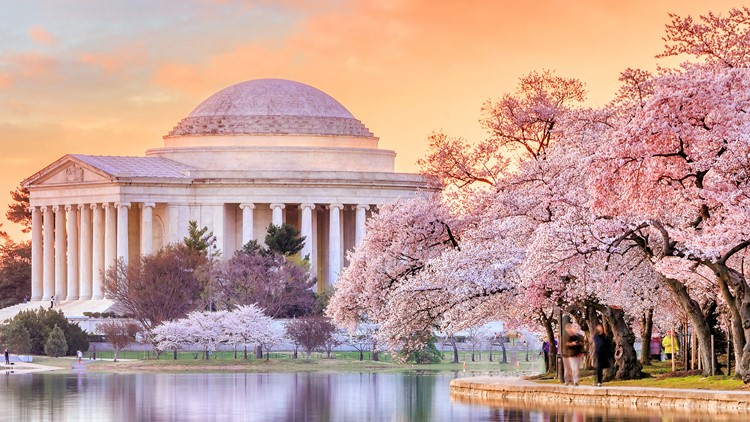WASHINGTON — The nation's iconic spot for enjoying cherry blossoms is one of America's 11 Most Endangered Historic Places, The National Trust for Historic Preservation announced Thursday.
The Tidal Basin on the National Mall needs as much as $500 million to upgrade and maintain one of the country's most visited sites. The 2019 National Trust list highlights 11 architectural and cultural sites the private nonprofit deems at risk because of neglect, development or other threats.
Part of the problem in the Tidal Basin is the popularity of the cherry trees, whose original stock was a gift from Japan in 1912. Every year, 36 million tourists crowd the walkways, trample on the trees' roots and compact the soil.
"The Tidal Basin is at a pivotal moment," Jeff Reinbold, acting superintendent for the National Mall and Memorial Parks division of the National Park Service, said earlier this year. "The area was never designed for the kind of use it sees today."
► APRIL 3: D.C. organizations launch effort to Save the Tidal Basin
► MARCH 29: Climate change is changing when cherry blossoms bloom
Rising sea levels also have created chronic flooding problems in the 107-acre man-made reservoir on the Potomac River.
The area — home to the Jefferson, Martin Luther King Jr. and Franklin Delano Roosevelt memorials — gets flooded twice a day at high tide, making some walkways impassible. The entire basin, built on landfill in the 19th century, is slowly sinking and its seawalls are deteriorating.
The silt concentration in the water is shortening the cherry trees' life span, park service officials said.
On April 3, The National Trust for Historic Preservation and the Trust for the National Mall launched a three-year campaign called #SavetheTidalBasin to raise money and awareness of the problems.
Other places on the National Trust's list:
• Buffalo, New York. Willert Park Courts was New York State's first housing project built specifically for blacks. Today the buildings, which still have bas-relief artwork depicting scenes of everyday life, is vacant and the city's municipal housing authority wants to demolish the complex.
• Charlotte, North Carolina. The Excelsior Club, an African-American social club, hosted artists such as Nat King Cole and Louis Armstrong during its heyday but needs significant renovations. The property, once listed in The Negro Motorist Green Book for black travelers looking for safe places in the Jim Crow South, is for sale for $1.5 million.
• Bismarck, North Dakota. The Bismarck-Mandan Rail Bridge, built in 1883, connects Bismarck and Mandan, North Dakota and was the first rail bridge across the upper Missouri River. The bridge has been recognized as an International Site of Conscience for the role it played in opening the western United States to white settlement and the resulting effects to Native American communities.
BNSF railroad, formerly the Burlington Northern-Santa Fe, wants to tear it down.
• Chicago. Within two years, Illinois plans to sell the James R. Thompson Center, Chicago's best example of grand-scale postmodern architecture, to help balance the state budget. The danger is that its sale could mean its demolition.
• Dallas. Former slaves settled the 10th Street Historic District after the Civil War, but a 2010 change to a local ordinance allowed the city to obtain demolition permits for houses less than 3,000 square feet without a Landmark Commission review. At least 70 of the district's 260 homes have been razed.
• Lares, Puerto Rico. Hacienda Los Torres, built in 1846 during the height of Puerto Rico’s coffee industry, is one of the few remaining coffee plantation houses on the island and one of the oldest structures still standing in the U.S. territory. It’s also associated with the island's short-lived 1868 rebellion of Spanish rule and the Spanish-American War.
• Mount Vernon, Alabama. The Confederacy captured Mount Vernon Arsenal during the Civil War and the U.S. government housed Geronimo and about 400 Apache prisoners of war during the 1880s and 1890s. Searcy Hospital, on the grounds of the arsenal, was a segregated mental health facility for African Americans after 1900.
It closed in 2012 and is deteriorating.
• Nashville, Tennessee. On Music Row, vital pieces of history are being lost because of development. Since 2013, 50 buildings have been demolished.
Many of those buildings housed small, independently owned music businesses, and much of the new construction consists of high-rise luxury apartments and offices that don't serve the music industry. The trust said naming Music Row to its list is a way to highlight concern about non-music development and urge city officials to protect it.
• Providence, Rhode Island. The city's iconic Superman Building, Rhode Island's tallest building at around 430 feet, is 91 years old and vacant. Formally the Industrial Trust Building, it resembles the Daily Planet headquarters in the old TV show.
Few buildings in Providence are as iconic or beloved, but the Superman Building has deferred maintenance needs after six years of without tenants, said Katherine Malone-France, the National Trust's interim chief preservation officer.
• Southeast Utah. The Bureau of Land Management escalated oil and gas leasing in the region that archaeologists believe to be one of the country's most culturally rich but unprotected areas for Native American settlements.




